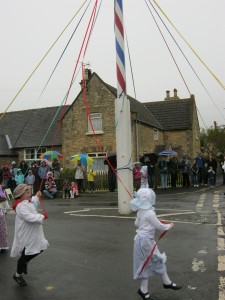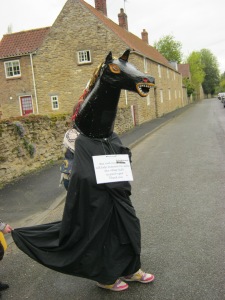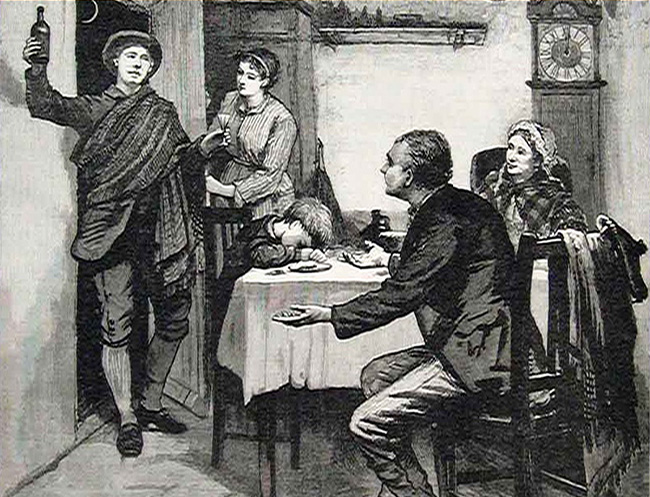A cursory glance of a book on Calendar customs will find no mention of the Hemswell May Day. This is a shame for although the present celebration is not of a great vintage, it is claimed that Hemswell maypole dancing celebrations in the world dating significantly back to 1660, the year of the Restoration. However, the earliest record of the Maypole is from the street name first recorded in 1841.It is noted that the weathervane was added in 1859, Gutch and Peacock (1908) in their work on Lincolnshire folklore notes:
“Hemswell Maypole. — On a recent visit to the neighbourhood of Gainsborough, I went to Hemswell, a village at the foot of what is termed ‘ The Cliff,’ in the northern division of the county of Lincoln. In the centre of the village I was surprised to see a Maypole. The pole proper stands between two stout posts about fifteen feet high. Near the top of them a strong iron bolt is passed through the whole. The posts are fixed firmly in the ground, while the pole between is loose at the bottom, but kept in place by a second transverse bolt near the ground, which is drawn out when the pole is wanted to be lowered; which is done by getting a ladder and fixing a rope high up on the pole, by which it is pulled down, swinging on the top transverse bolt as on a pivot. It is steadied by another rope at the bottom. When decorated it is raised to its place again by pulling the bottom rope, and it is fixed by reinserting the lower transverse bolt.”
The authors do not appear to describe any use of the Maypole and the earliest record of its use being pictures of the early 1900s. It is known that it was lowered and repainted in 1919 by the village carpenter, a Charles Love at the cost of 25/-. However, by the time Rudkin (1936) describes it, the correspondent appears to suggest such events were a thing of the past:
“Feast week was in Maytime (ie Mayweek first week in May) and there used to be stalls all in the street round the maypole. There was ‘good-stiff’ stalls and sweetmeat stalls and aunt sally a rare fine show it was!As a little ‘un I remember it and id 4d to spend so I spent it all in halfpence – and I did buy a lot with that 54d! We danced at nighttime round the Maypole, but only ordinary round dances, none of those dances with ribbons attached to the pole – I never heard tell of that being done pers Mrs H of Hemswell.”
She is more emphatic in the County Magazine (1934-6), as Rudkin notes:
“Hemswell is our only village that can boast of a Maypole still in position..but all traditions about dances or other doings are now dead in the village itself.”
May be old or Maypole be not!
Allen (1994) in her work The Hemswell Maypole notes however and a Mr. Senior in 1977 could remember a youth climbing it to put some briads on it. Allen (1994) suggests that the attempt was unsuccessful as he could not recollect any dancing. It appears if a Mrs Edith Bamford is correct with her recollection in 1986 when 87 that the tradition of Maypole dancing was kept alive by the school having a portable maypole. Certainly photographs from the 1950s show this. Despite this repairs were made in 1957 and 1964. It appears probable that the custom was revived in 1976 when the Lincoln Folk Dance society asked if they could use it. They brought their own braids and a May Day was established and now dancing and a small fete is held around the Maypole area and parish hall on the May Bank Holiday. The braids due to the difficulty of reaching the top of the pole are set mid way up. Now the children wear a special costume with boy’s smocks patterned to denote their work and girls with long cotton skirts, aprons and fen-bridle style cotton bonnets. Over the years Allen (1994) notes:
“Sometimes a May Queen has figured in the celebrations; the Lincolnshire Morris Men have often joined us, and other visitors have included the Lincoln Folk dance society, the Tatterfoals, and Dukes Dandy Clog Dancers, all bringing their particular brand of tradition.”
Only a hobby
One of the most interesting aspects of the day is a hobby horse – more horse like than others, which collects money and appears from all accounts to be a familiar feature although it is isolated from the dancing and appears to not to be associated with a Morris team. He wanders around with a note asking for money for his stable – the village hall! One wonders the origin of it, of course Obby Oss are associated with three West Country May events and certainly Rudkin refers to one in nearby towns of Grimsby where a sadly colourful defunct May pole day records:
“And there was also Robin Hood, the Friar, the fool, the dragon and the Hobby Horse, all robed in character.”
Such a cavalcade of characters may suggest similar disguises where undertaken at Hemswell, but only the Hobby Horse remains, a person completely covered with a sheet with a horse’s head on top carved out of wood. A bonus as the Hobby Horse is certainly a unique feature to Hemswell and one which looks vert old.
From the revival in the 1970s this quiet local celebration has continued. In 1992 when the pole was weathered for 5 years previous and a new brass fox placed on the top of its 17th feet, ensuring perhaps at least another 100 years of May days…so long may this remote location celebrate the May with their very own Maypole.

















